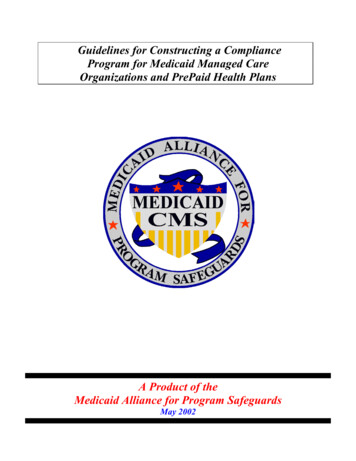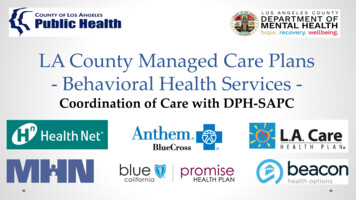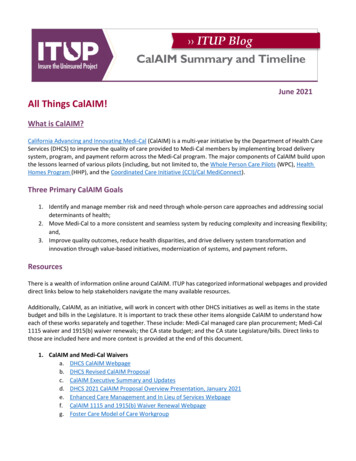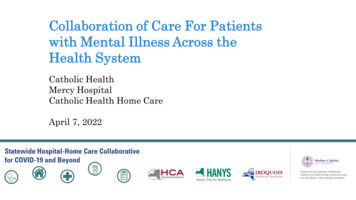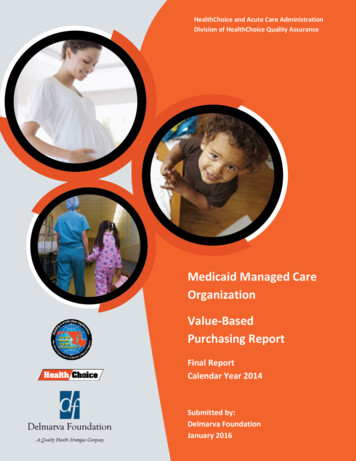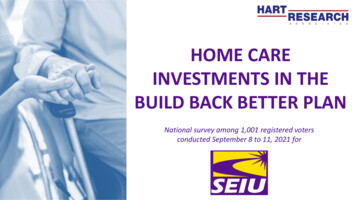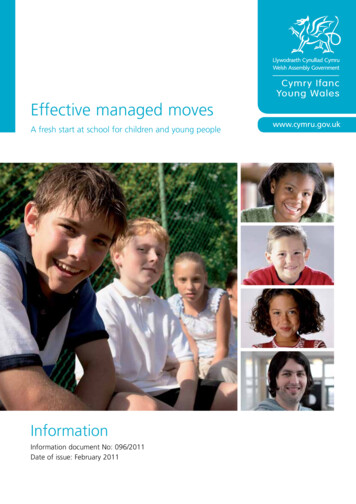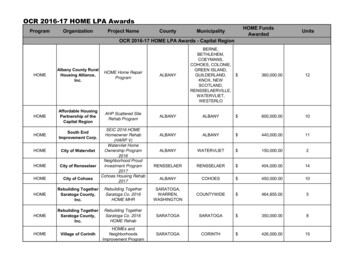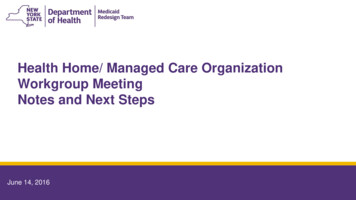
Transcription
Health Home/ Managed Care OrganizationWorkgroup MeetingNotes and Next StepsJune 14, 2016
June 14 2016Proposed Agenda Welcome- IntroductionsUpdates on Children’s Health HomeUpdates HHDFUpdate on Billing CommitteeUpdates on Revised Workflow – Feedback and Problem Solving SessionFAQs Non- Medical Transportation Consent and Communication HML- Approved Revisions Review Summer Schedule Next Steps2
Hot Topics HARP BH HCBS WORKFLOW- POC EXCHANGE ETC Updates BILLING HML-UPDATE- Todays Topic MAPP-HHTS- updates ENROLLMENT- updates PERFORMANCE MEASUREMENT and QUALITY IMPROVEMENT PERSON CENTERED CARE PLANNING– COMMUNICATION BTWN MCO AND CMA’S Incidents and Complaints ACT Intersection of DOH/OMH regulation REDESIGNATION- Site visit follow-up what feedback to expect and when
Reminder: Administrative Service Agreements (ASAs) DueJuly 1, 2016 Only 3 plans have submitted revised ASAs applicable to all Health Homes (those servingadults and those serving children) to reflect the January 2016 ASA revisions ASAs are due for all Health Homes (including those serving children) by July 1, 2016 There are three new Health Homes that will only serve children for which ASAs arealso required Completing ASAs in timely manner is critical to staying on track for beginning to enrollkids in Health Homes October 1, 2016 ASA DOH Standard Agreement (January 2016) http://www.health.ny.gov/health care/medicaid/program/medicaid health homes/docs/administrative health home services agreement.pdf ASA Key Contract Provisions for Customized ASAs (February 2016) http://www.health.ny.gov/health care/medicaid/program/medicaid health homes/docs/mco contract provisions.pdf
Health Home Serving Children Updates Enrolling children in Health Homes is scheduled to begin October 2016 ASAs are due by July 1 for all Health Homes 3 new Health Homes serving only children and MCO’s will need to execute for first time an ASA and should be working to executethose ASAs Completing new ASAs in timely manner for all Health Homes is critical to staying on track for beginning to enroll kids in HealthHomes October 1, 2016Last Comprehensive Webinar on Readiness and Implementation Activities for Launching Health Homes for Children was April 7, 2016 Reminder: All Health Home Serving Children Design and Implementation Webinars can be found athttp://www.health.ny.gov/health care/medicaid/program/medicaid health homes/hhsc webinars.htm Health Home State Plan approved in April, includes use of CANS-NY assessment to determine High Medium Low billing for children, referral ratherthan assignment list (see April 7 Webinar for more details) Modifications to Health Home eligibility criteria for children: Serious Emotional Disturbance (SED) (Health Home definition) and Complex Trauma(CMA/SAMHSA definition) as single qualifying conditions for Health Home eligibility – Work group developing processes for determining ComplexTrauma eligibility by licensed professional DOH is working to schedule in late June early July Health Homes Serving Children Webinar just for the Plans Through Plan Associations, DOH has requested a list of questions/ topics plans are most interested inTraining Schedule for Summer (see website and slides)
Systems Modifications for Health Homes ServingChildren MAPP Health Home Tracking System Modifications Underway for October Enrollment ofChildren in Health Homes: Children’s referral portal, consent Billing for children’s rates from CANS-NY algorithm and connectivity between MAPPand UAS Uniform Assessment System (UAS) - CANS-NY will be housed in Uniform AssessmentSystem Training for access to and use of the MAPP Referral Portal and UAS will occur in theSummer/Fall of 2016 Users will be required to obtain a Health Commerce System (HCS) ID in order toaccess the MAPP referral portal and UAS
Health Home Serving Children (HHSC)Training Schedule – JUNE and JULY 2016
Health Home Serving Children (HHSC)Training Schedule – AUGUST 2016
Health Home Serving Children (HHSC)Training Schedule – SEPTEMBER 2016
Health Home Development Funds June’s Health Home Development Fund payment may be delayed due to the data conversion from the old HHTS intoMAPP HHTS Semi Annual Spending Reports Update March reports received have been reviewed and feedback will be coming out to the health homes shortly 7 of 31 Health Homes still have not submitted the March 2016 spending report – emails were sent directly to thesehealth homes Next spending report is due in September 2016. There will be a new template to use for this report,communication will be coming out shortly on when the new template will be available on the Health Home website The Department is currently reviewing all spending reports to verify that totals reported under “Total Amount of HHDevelopment Funds Received to Date” match what has actually gone out to each Health Home Reports are also being reviewed to see how much money has already been spent to date, as well as the percentageremaining to be spent by each health home. DOH will be reaching out to Health Homes directly to discuss any questions or concerns we have with HHDF reports
Billing Subcommittee First meeting Monday 6/13/16 updates: Jessica Fear Discussed plans likeness and differences across plans Remittance advice who they are paying and what they are paying for 30-45 days from billing support to sending out the door Details to be submitted to DOH Need more information about improving remittance advice Manual process-Health Homes have met and are collecting more detailed information Mapped out the process- for plans and timeframesDates to examine the issues urgency to get this rectifiedDiscussion Next Steps DOH will require updating attestations for billing timeframes Plan workflow in detail Millan and BTQ- need to be at the table and TAT need to fit within HH 15 days for both legs of the workflow Payment for assessment - pending billing guidance and tools to make the CMHA data feed more efficientNext Meeting: Preliminary Recommendation HH/MCO workgroup July 15
BH HCBS Plan of Care Updates Data total number of assessments Total number of POC submitted Total number of Approved services Issues? Opportunities? Add webinar links to HCBS services: emphasis on three minimum requirements Recommendations Training in person - Pre recorded webinars on every step of the process Utilization management – can plans assist with this HCBS provider seeking guidance on the assessment process How to use interdisciplinary team to get POC completed Partial or failed attempts?Health Homes and CMAs should use all available resources to train HHCMshttp://mctac.org/page/get-the-right-tools/
All NYC HH and CMA should registerNe w M CTAC In-Pe rson Training Offe ring:Adult BH HCBS Plan of Care & Expe dite d Workflow TrainingRe giste r now for an in person training on the Adult BH HCBS Plan of Care & Expedited Workflowon June 20th in New York City. MCTAC and state partners will walk through the Plan of Caretemplate and the Expedited Workflow. This training is geared towards NYC Health Home CareManagement supervisors, MCO representatives, and Health Home Lead staff. The training willcover: Plan of Care guidanceExpedited Adult BH HCBS WorklowQ&A with MCTAC and State partnersDate and time : June 20th, 9am-1pmLocation: NYU Kimmel Center, Rosenthal Pavilion (10th floor), 60 Washington Square SouthNew York, NY 10012Register here!*The slides from this presentation will be made available on MCTAC.org at a later date. Coffee,tea, and water will be available for training participants.
Non- Medical Transportation General Designation Information REMINDER: To provide this service you must be or become a Medicaidtransportation provider If you are NOT a Medicaid transportation vendor, you will unable to provideNon-Medical Transportation In order to become certified by Medicaid, you must complete a New YorkState Medicaid Enrollment form ransportation/index.aspx
Non-Medical Transportation Services In addition to any medical transportation furnished under 42 CFR 440.17(a) in the StatePlan, Non-Medical Transportation may be available to individuals receiving BH HCBS inHARPs and HIV SNPs Non-Medical Transportation will be paid Fee For Service (FFS), the same way regularMedicaid transportation is paid. Regular Medicaid transportation covers trips to and fromMedicaid-covered medical appointments There are two types of Non-Medical Transportation: Trips to and from BH HCBS that are included in the Plan of Care (POC) Trips to and from non-HCBS destinations (e.g. job interview) that are time-limited/non-routine (with astart and end date) and specifically tied to a goal related to recovery from mental health or substanceuse disorders in the individual’s POC (see the guidance manual for examples of qualifying trips) 2,000 cost cap per individual per year – excludes public transportation and transportation to and from BHHCBS in the POC
Examples of Non-HCBS LocationsSpecifically Related to Goals in POC All goals are to be met within a specific timeframe. Requests for transportation to a service associated with the goal that aresubmitted outside the specified timeframe will not be considered. Non-Medical Transportation cannot be used for routine transportation to and from a job or school. For example, a participantmay be transported to a job interview, but not to work on a daily basis. Similarly, a participant may be transported to a collegefair, but not to classes on a regular basis. The frequency of these trips should be included in the plan of care with a specifictimeframe defined including a start and end date.
Non-Medical Transportation Grid Health Home Care Managers are responsible for completing the “NYS Behavioral HealthHome and Community Based Services (BH HCBS) Plan for Transportation Grid” (Grid) basedon the BH HCBS and goals in an individual’s POC The Grid is only to be completed if an individual requires Non-Medicaid Transportation, andthis grid should NOT include regular Medicaid transportation (i.e. trips to Medicaid-coveredmedical appointments) The care manager will send the completed Grid to the Managed Care Organization (MCO)along with the POC As soon as the POC is approved, the MCO is responsible for forwarding the Grid to thetransportation manager (e.g. LogistiCare) to ensure that individuals’ non-medical trips (NMT)can be authorized. Note that the transportation manager also coordinates the transportationfor other Medicaid covered transportation If the services or goals within the POC require NMT change, then the Grid needs to be resubmitted by the care manager to the MCO and from the MCO to the transportation manager
Non-Medical Transportation Grid
Which Mode of Transportation is Necessary? The same, appropriate mode of transportation used by the participant for standard medical trips should beused for non-medical transportation trips, and vice versa Assessing the most cost effective and medically appropriate mode of transportation. Medical Justification “2015” Form: Requires a medical professional to provide the mobility-related reason why the enrollee requires aspecific mode of transportation Reasons for decreased mobility could be that the enrollee is wheelchair-bound, underwent recentsurgery to a limb, is blind, or has an unstable gate. Must be signed by a medical professional and sent to the transportation manager Reviewed, approved and filed by the transportation manager Audited by the Department and transportation manager Many individuals will already have this form on file if they are already receiving regular Medicaidtransportation This form is not needed for public transit
Where to send completed grids LogistiCare Solutions, LLC Fax to (877) 564-5928, or Email to HARPNYC@logisticare.com Attn: HARP CARE PLAN GRID
Guidance for Non-Medical Transportation The “Guidance for Behavioral Health Home and Community Based Non-MedicalTransportation Services for Adults in HARPs and HARP Eligibles in SNPs” can befound at the following ortation/PDFS/HARP Guidelines Non-Medical Transportation.pdf The guidance document includes: Definition of Non-Medical Transportation Roles for Health Home Care Managers, MCOs and Transportation Managers Guidelines for Non-Medical Transportation
Questions on Non-Medical Transportationin New York City Contact the State Transportation Team for general questions related to NMT:MedTrans@health.ny.gov Contact LogisitiCare for specific questions in NYC:
Health Home Rates: High, Medium, and Low (HML) Rates withClinical and Functional Adjustments Effective September 1, 2016 Effective 9/1/16, the monthly HML Assessment questionnaire is used to determinethe rate code a member should be billed under for a that month. HML Assessment created and approved by the HH/MCO Workgroup and usesclinical/functional questions to determine a member’s HML status for each monthbased on real time member attributes. Providers should answer any questions that don’t apply to a member or anyquestions that they cannot answer with unknown. Each answered question qualifies as either High, Medium, or Low (see followingslides).Discussion:Frequency of acuity and risk - if HARP is done quarterly- can acuity and risk becalculated qtrly?
Health Home Rates: High, Medium, and Low (HML) Rates withClinical and Functional Adjustments Effective January 1, 20161.Does the member have at least one response in the “High” category? Yes – bill for member using the “High” rate code No – see # 22.Does the member have at least one response in the “Medium” category? Yes – bill for member using the “Medium” rate code No- see # 33.Bill for member using the “low” rate code
MAPP HML Monthly Billing Assessment Questions(see Billing Support Upload File for fields collected through file upload)
High, Medium, and Low values for HMLClinical and Functional Adjustments
AIDS Institute Clinical Guidelines CD4 testing is recommended at 12 weeks and every four months after initiation ofARV until CD4 is 200 cells/mm3 on two measures. For those who are virally suppressed, CD4 testing is recommended at least every6 months if CD4 is less than or equal to 300 cells/mm3; every 12 months if 300 cells/mm3 and less than or equal to 500 cells/mm3 optional if CD4 greater than 500 cells/mm3.Opportunities suggested in discussion: Future enhancements- build in an alert for documentation Refine documentation and consider the human factor consider 6 monthoverall
Viral Load Test TimingPractitioners agree that a six month period for more aggressive care management isappropriate for an HIV member with a medium or high range viral load, eventhough they should be tested again within that period. quarterly for HIV persons with recent history of non-adherence, MHdisorders, SU, poor social support, or other major medical conditions: every 4 months for most individuals after complete viral suppression; every 6 months for those with complete suppression for over 1 year and CD4counts greater than 200 cells/mm3. Note, when a person is failing virologically, testing is recommended within 4weeks from a change in ARV, and at least every 8 weeks until completesuppressed
High, Medium, and Low values for HMLClinical and Functional Adjustments
High, Medium, and Low values for HMLClinical and Functional Adjustments
Required Documentation Self Report is acceptable documentation for M and L rates during the first 30 days of billingand is reviewed and approved by a supervisor. Required documentation to support rate level thereafter. Self Report is not acceptable on its own for documenting a high rate however in someexamples documentation of an intervention that informs the plan of care may beconsidered documentation. The subcommittee will develop examples for consideration and final approvalDiscussion: Can the county be a means for documentation for incarceration? HH are finding larger than anticipated H- non HARP category HH finding larger L rates – HARP Can SDOH review this data and verify ? Evaluate? Opportunity for acuity and risk be calculated more frequently? Real time? Qtrly?
Current DocumentationFunctional LimitationHomessnessIncarcerationIP Stay for Mental IllnessIP Stay for SUD TreatmentSUD Active Use/FunctionalImpairmentRequired Documentation*Self-report, letter from shelter, hospital d/c summary*Self-report, release papers, documentation fromparole/probation, documented conversation fromcollateral contact, Print-out from Webcrims, Letter from1/2 way houseSelf-report, hospital d/c summary, documentedprogress note (including name, title, contactinformation of person on inpatient unit who verifiedpatient's d/c date), print out from Psyckes, or MCOconfirmation*Self-report and hospital d/c summary, documentedprogress note (including name, title, contactinformation of person on inpatient unit who verifiedpatient's d/c date), print out from Psyckes or MCOconfirmationSelf report and Patient, Hospital records, Collateralcontact, HRA, Parole/probation, MCO confirmation,family,
Reportable Timeframes MAPP-HHTS requires monthly attestation Clinical and Functional adjustments auto populated and should be updated whenthere is a change Functional adjustment questions requiring a date auto calculate timeframes Recently released from prison June 2016 – bill H rate code and auto adjust toM rate code January 2017 HUD CAT 1 Homeless and housed on May 2016 bill H rate code and autoadjust to M rate code December 2016
Health Home Rates: High Medium and Low Rates withClinical and Functional Adjustments Effective September 1,2016Health Home Rates - High, Medium and LowPopulationRegionLowMediumHighHARPDownstate 125.00 311.00 479.00non -HARPDownstate 62.00 249.00 383.00HARPUpstate 117.00 293.00 450.00non -HARPUpstate 58.00 234.00 360.00Other Health Home RatesRateHealth Home Plus *Downstate 800.00Health Home Plus *Upstate 700.00Adult Home **Downstate 700.00OutreachStatewide 135.00* Limited to AOT members that are not receiving ACT services.** Limited to Impacted Adult Home members assessed for transition to the community.If an impacted Adult Home member transitions to the upstate region, the rate is 563.
HML Questions Discussion: Incarceration LGU- Comparing data by DCJ - follow up with Kelly Hansen what is “incarceration” to refine and define clearly Acuity and Risk calculated annually- can it be more frequently ? Rates based on HML questionnaire and acuity and risk Answer all “no” on the HML but H –rate is possible due to risk and acuity
Summer Schedule: Video Conference Capability July 15, 2016 1450 Western Ave. Albany - Main Conference Room, 4th fl. 501 7th Ave, NYC, Conf Room A August 19, 2016 44 Holland Ave, Albany - 8th fl. Conf Room 501 7th Ave, NYC, Conf Room A September 16, 2016 1450 Western Ave. Albany - Main Conference Room, 4th fl. 501 7th Ave, NYC, Conf Room A
Next Steps .Follow up items from todays workgroup: Billing subcommittee: Plans and HH to review respective billing workflow andtimelines and prepare preliminary recommendations for July 15 Workgroup HML Subcommittee: refine and define examples of documenting intervention forH-rate Conference of Mental Hygiene Directors - Kelly Hansen interested in assistingwith defining and refining “Incarceration”- SDOH-follow up: Frequency of acuity and risk calculation- qtrly possible? HHDF: Is there a timeline to expend the HHDF?
Health Home Serving Children Updates Enrolling children in Health Homes is scheduled to begin October 2016 ASAs are due by July 1 for all Health Homes 3 new Health Homes serving only children and MCO's will need to execute for first time an ASA and should be working to execute those ASAs Completing new ASAs in timely manner for all Health Homes is critical to staying on track .
